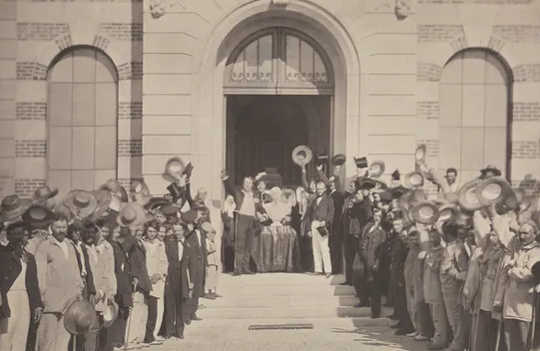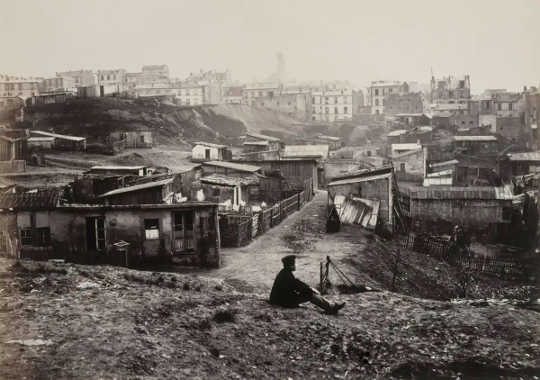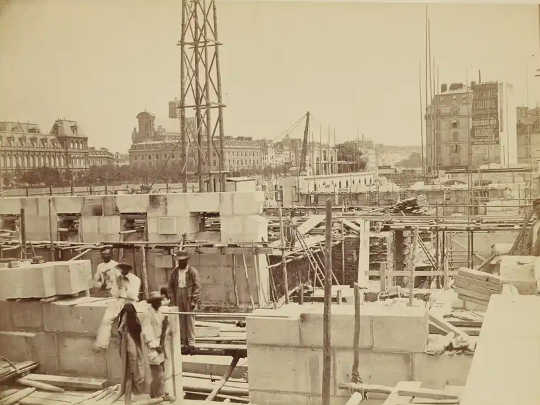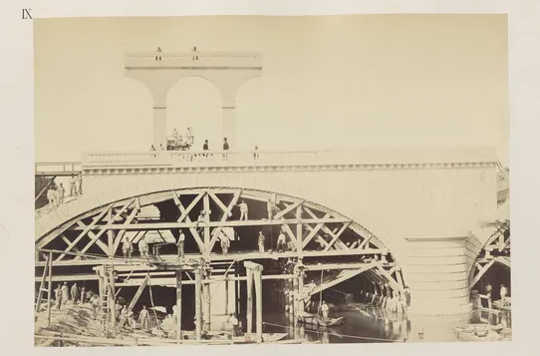
Patients of the Imperial asylum at Vincennes celebrate Emperor Napoléon III. Charles Nègre, [The 15th of August. Imperial Asylum at Vincennes], 1858. The Metropolitan Museum of Art.
Louis-Napoléon Bonaparte, ruler of France from 1848 to 1870, was “the most enthusiastic supporter of photography in all of Europe”. He stocked his libraries with countless photographs of bridges, parks, army camps, railways, and palaces. These structures were his most important achievements and he commissioned a panoply of photographers to celebrate them.
First publicly demonstrated in 1839, photography was a modern, scientific marvel – its realism, accuracy, and truthfulness astounded 19th-century viewers. In the 1850s, these associations primed it to become an essential propaganda tool. Even medical photography became political.
Yet, as the photographer Charles Nègre discovered when he visited the Asile impérial de Vincennes – a convalescent hospital for working men founded by Louis-Napoléon – bodies were more difficult to politicise than bridges. Disabled by amputation and infected with typhoid, the asylum’s patients did not fit easily into Louis-Napoléon’s self-aggrandising propaganda. To win official approval, Nègre had to censor their afflictions.
Highlighting progress

Charles Marville, Haut de la rue Champlain (vue prise à droite), 1877-1878. Musée Carnavalet, Histoire de Paris
Louis-Napoléon inherited a cramped, crumbling and crime-ridden capital. Paris’s one million inhabitants lived cheek-by-jowl in a vast tangle of densely packed buildings. There was even a slum in the courtyard of the Louvre.
Modernising Paris promised more than practical benefits: “I want to be a second Augustus”, wrote Louis-Napoléon in 1842, “because Augustus … made Rome a city of marble”. It meant glory. So, he hired a ruthlessly efficient administrator, Baron Haussmann, to knock down the old slums.

Delmaet & Durandelle, [Construction Site in Paris], about 1866. Digital image courtesy of the Getty’s Open Content Program. The Getty
The city became a building site. Charles Marville’s photographs record the squalor of the slums, the chaos of their transformation, and the spectacle of their rebirth. Thousands of men were drafted into an army of construction, battling away on this new “field of honour” for the glory of the nation and its increasingly power-hungry leader.
![Charles Marville, [Rue de Constantine],about 1865. Charles Marville, [Rue de Constantine],about 1865.](/images/2020/540/09-04-1-how-napoleon-iii-used-photography-as-propaganda-to-hide-the-horror-of-his-new-paris.jpg)
Charles Marville, [Rue de Constantine],about 1865. The Metropolitan Museum of Art
In December 1851, Louis-Napoléon overthrew the Second Republic and made himself Emperor Napoléon III. Liberal democracy was replaced by populist authoritarianism. To compensate, Napoléon III promised a bounty of progress and benevolence, especially for the working-class – as he put it: “those who work and those who suffer can count on me”. The legitimacy of his rule depended on his being believed. Any evidence to the contrary put him in real danger, not least from the rebellious Parisian workers. As one commentator put it: “A week’s interruption of the building trade would terrify the Government”.
Napoléon III and his ministers called upon photographers to help him walk this tightrope. In addition to Marville, they commissioned Édouard Baldus to record the renovation of the Louvre, Auguste Hippolyte Collard to document Paris’s new bridges, and Delmaet and Durandelle to showcase the city’s new opera house. Their photographs offered tangible proof of progress.

Auguste Hippolyte Collard, Chemin de fer de ceinture de Paris (rive gauche): Pont-viaduc sur la Seine au Point-du-Jour, 1863-1865. Bibliothèque nationale de France
Collard’s view of the rebuilt Point du Jour bridge is typical for its emphasis on the superhuman scale and clean geometry of its subject. Other photographers approvingly compared Napoléon III’s bridges to Roman aqueducts – Collard instead contrasts the structure to the workers erecting it. Their tiny bodies, “trapped in the labyrinth of scaffolding”, are visually dominated by the bridge, which, stamped with the imperial “N”, is a tangible artefact of Napoléon III’s achievement. The photograph’s political message is clear: work for the masses, glory for the Emperor, modernity for France.
Hiding disability
Yet, as Napoléon III’s interior minister knew, “industry has its injured like war” and the rebuilding of Paris too had its “glorious war-wounded”. In 1855 Napoléon III ordered the construction of a convalescent asylum to care for workers injured during the building works.
Charles Nègre visited the asylum around 1858 to photograph its buildings, patients, and staff. To get paid, Nègre knew he had to toe the party line. Yet, the bodies he encountered had been wounded in the war for Napoléon III’s self-aggrandisement, giving the lie to his image of populist benevolence. Nègre’s challenge was to celebrate Napoléon III’s care for their suffering without revealing his culpability for it.
Nègre began his album with a scene of the patients and staff of the asylum paying homage to their benefactor. (See picture at the top of this article.) Nègre organised the patients into two geometric blocks, angled to draw our attention towards Napoléon III’s marble bust, placed in the centre, and away from individual patients, whose stoic faces and discreet walking sticks blend into a seamless whole.These working men are visually subsumed within a superhuman structure akin to Collard’s bridge. While the bridge symbolised progress, this unified mass of bodies offers a metaphor of social cohesion and “national gratitude” towards the Emperor.
In other photographs, Nègre focused on the asylum’s modern architecture and efficient staff. Patients are shown eating, playing and reading, as if on holiday. Nègre dared to show medical care only once but even then ensured the patient was so tightly bandaged as to disappear. The visibility of Napoléon III’s benevolence depended on the invisibility of his subjects’ illnesses and disabilities.
In the 1850s photography was typically used to discover, rather than disguise, illness. In England, Dr Hugh Diamond photographed his “lunatic” patients because he trusted photography’s minute detail to capture hidden diagnostic clues. During treatment, he showed patients these portraits, believing the medium’s inherent truthfulness and arresting novelty would shock them into recognising their own illness.
Nègre broke from this emerging medical consensus under political pressure and his meagre finances made him desperate for state subsidy. His photographs, in trying to tell us so much about Napoléon III, tell us so little about the asylum’s patients. Photographs, even of bridges or hospitals, are never neutral: they are a tissue of the choices made by the photographer. In choosing to tell one truth, photographers can obscure many others.![]()
About the Author
Samuel Raybone, Lecturer in Art History, Aberystwyth University
This article is republished from The Conversation under a Creative Commons license. Read the original article.























